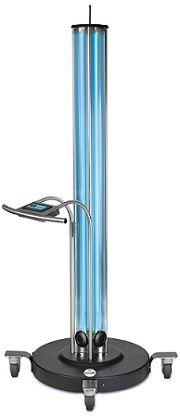UV Light Kills Infections, Cuts Costs
Clostridium difficile infections (C. difficile) are common, costly, and potentially fatal. But UV light can kill them.

Clostridium difficile infections (C. difficile) are common, costly, and potentially fatal. Often transmitted in hospitals, they can be an unpleasant and expensive consequence of entirely unrelated admissions. Short-wavelength UV light can kill microorganisms, including C. difficile bacteria.
In three of the hospital’s hematology-oncology units, the researchers supplemented normal disinfection protocols with the use of UV-C disinfection robots (made by Clorox, pictured left) following 21% of patient discharges over the course of the year. Subsequent patients in these rooms had a 25% reduction in incidence of C. difficile infection, while the units that just used standard cleaning methods actually saw an increase of 16%.
Clinical effectiveness aside, the additional disinfecting step added only 5 minutes to room turnaround. The study estimates that the simple step could save the hospital between $350,000 and $1.5 million annually in healthcare costs. UV-C disinfection, particularly by robot, is considered safe and effective.
The use of the UV-C robots could be tailored to disinfect hospital units or rooms of patients at specific risk. The study concludes that “Targeted deployment of UVGI to rooms of high-risk patients at discharge resulted in a substantial reduction of CDI incidence without adversely impacting room turnaround.”
While seemingly effective against the spread of C. difficile, UV-C disinfection does not kill all hospital-borne infections, and in the study it showed no impact on Staphylococcus aureus, commonly known as MRSA. Still, cutting down C. difficile frequency alone could be a major benefit. Further studies may be needed to convince other hospitals to invest in the process, but early indications are that the introduction of UV-C disinfection could save healthcare costs and even lives.
The study spanned a year and was conducted at the Hospital of the University of Pennsylvania published this week in Infection Control & Hospital Epidemiology highlights the value of disinfecting hospital rooms with ultraviolet C (UV-C) light.
(photo courtesy of Clorox Healthcare)
Podcast: Match Made in Hospitals — Patient-Matching Technology Can Improve Healthcare
September 21st 2021Clay Ritchey, CEO of Verato, highlights the administrative and financial benefits that patient-matching technology can provide hospitals and health systems, as well as how it can improve the patient experience.
Podcast: Using Digital Solutions to Address Technology Shortfalls with Citius Tech Senior VPs
July 29th 2021In an interview recorded earlier this year, Chief Healthcare Executive Associate Editorial Director Mary Caffrey spoke with 2 leaders of Citius Tech about meeting healthcare challenges with digital solutions.